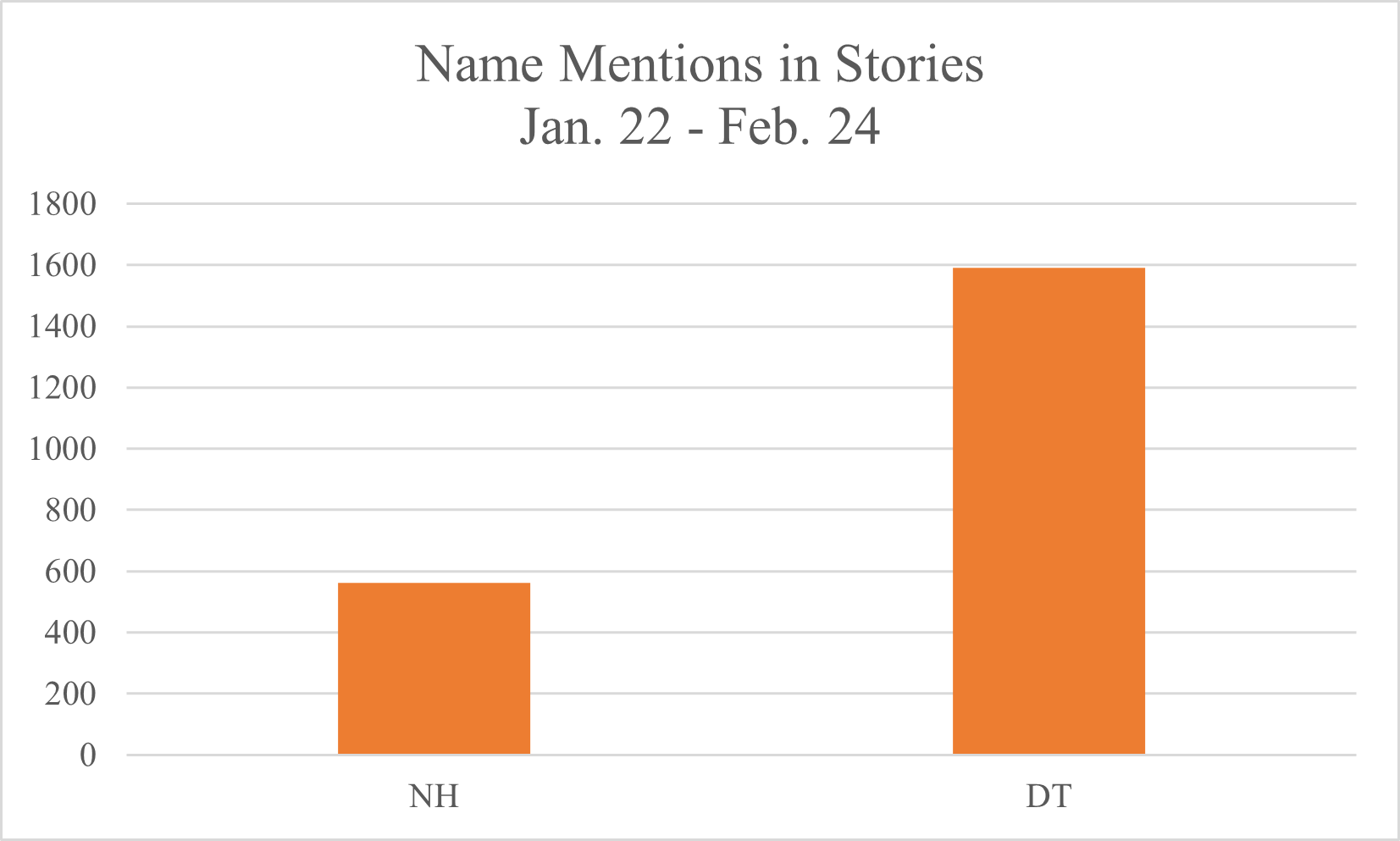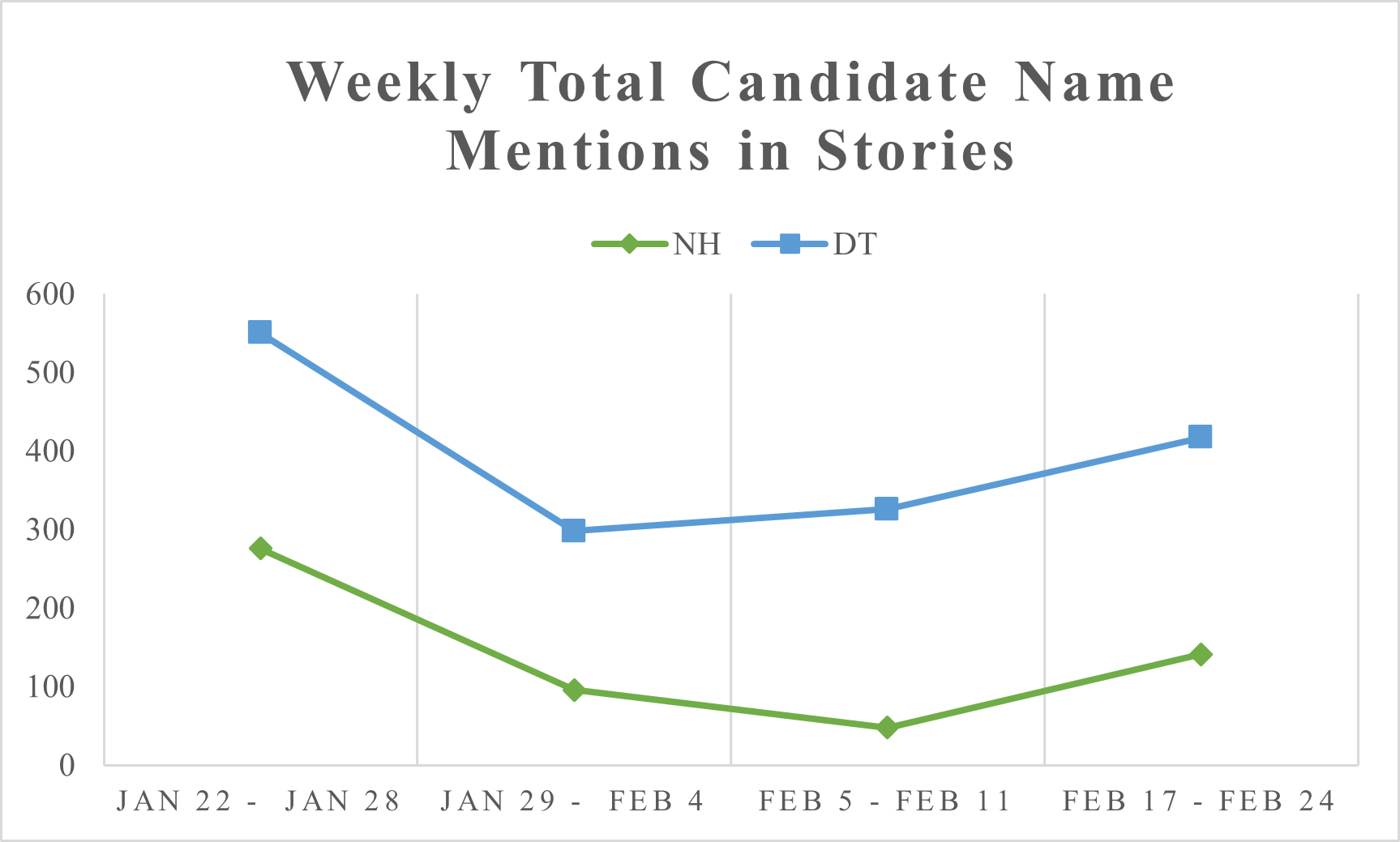Disproportionate News: Name Mentions of Presidential Candidates During Early Primaries
Photo by Suzy Hazelwood from Pexels
CivicStory conducted a month-long informal survey of election news stories from the week of the New Hampshire primary to the South Carolina primary (Jan. 22 to Feb. 24). Our aim was to find out if the amount of attention journalists gave to the two Republican primary candidates was reasonably equitable during the early weeks of the 2024 primary season.
We observed a large disparity. On average, one candidate was mentioned three-times more frequently than the other. What does this mean? We have some thoughts, and would love to hear your perspective.
Here are a few questions to consider before reviewing our full analysis below:
Are name-mention disparities by themselves a significant factor in news reporting, over and above the news content? Are higher or lower name counts throughout these sample stories a matter of reporting style and mannerisms, or are they intentional?
Might the disparities be algorithmically or “AI”-biased toward past norms and language-use patterns? Might business pressures contribute to excessive repetition of a name?
Is there an editorial bias toward a “party incumbent,” even though the candidate is not currently in office?
Might gender, age, or racial factors or stereotypes contribute to name-mention inequities?
How does the tendency to use sports and gaming metaphors (“match-up,” “favorite,” “finding a lane,” “battling,” “fighting,” “trouncing,” etc.) contribute to disproportionality?
What We Did and Did Not Count
Our method was simple: we tracked the number of times each candidate’s last name was mentioned in election-related stories and headlines. Specifically, we counted candidate name mentions in the body of each news story. The counts included hyphenated terms and contrived words such as “Trump-backed” or “Trumper.” These basic “name mentions” were recorded and analyzed independently of a story’s editorial bend. (We opted not to track Democratic candidate name mentions, since President Biden’s incumbent status would yield less meaningful data.)
Our source of stories was the New York Times. Although we surveyed reporting by other newsrooms including NPR/WNYC, the PBS NewsHour, The Star-Ledger/NJ.com and The Wall Street Journal, we ultimately tracked daily reports from one newsroom for a more consistent and meaningful data set. In total we reviewed 86 election-related stories from 29 print editions, and analyzed them in four tracking periods as follows: Jan. 22-28 (26 stories); Jan. 29-Feb. 4 (20 stories); Feb. 5-11 (20 stories); and Feb. 17-24 (20 stories.)
The story samples did not include news focused on a candidate’s legal or court-case issues unless the 2024 elections were referenced. In general, we did not track candidate name mentions in opinion pieces or editorials, with a few exceptions noted in the data. We also did not count name mentions in editorial subheadings or photo captions; titular descriptions of candidates (“former governor,” “former president”), names of family members, pronouns, or secondary headlines on the “jump” (inside pages of front-page stories).
Representing Names with Initials
Recognizing that names themselves convey meaning, we indicated candidates Haley and Trump more neutrally by their initials (N.H. and D.T.) in all graphs and analysis. In our data from stories and headlines, the candidates’ last names are symbolized by “H” and “T.”
Findings
Throughout all four story-tracking periods, we observed a large disparity in name mentions of the two candidates. On average, one candidate’s name appeared three times more frequently than the other’s (50 percentage points more.) During the week of Feb. 5-11, the disparity was extreme, with the over-reported candidate named seven times more frequently.
Full-Month Overview Jan. 22 to Feb. 24 (29 days)
The charts below show the number and percentages of name mentions of the two Republican candidates from Jan. 22 to Feb. 24, from the day before the New Hampshire primary to the day of the South Carolina primary. January 22 also marked the first full day with only two candidates in the Republican primary field (Florida Gov. Ron DeSantis suspended his presidential campaign on Sunday, January 21.)
Ex. 1 and 2
Totals and Percentages of Candidate Name Mentions in 86 stories from Jan. 22 to Feb. 24*
Ex. 1
Ex. 2
*The above graphs do not include news stories from Monday Feb. 12 to Friday Feb. 16. During that five-day period, news generated by legal and court rulings, the death of Alexei Navalny, and one candidate’s comments about NATO subsumed election news. Our story tracking resumed on Sat Feb. 17.
Weekly Trends
The line graph below shows weekly trends over the month from Jan. 22 to Feb. 24.
The second week shows a fall-off from intensive reporting immediately before and after the Jan. 23 New Hampshire primary. During the third week—including the Nevada primary and caucus—one candidate’s name mentions increased to 298, while the other’s decreased to 48. A remarkable disparity prevails throughout all four tracking periods.
Ex. 3. Weekly Total Candidate Name Mentions Jan. 22 to Feb. 24
Ex. 3
Eight Days Leading to the South Carolina Primary
The graphs below show name mentions in 20 stories during the eight days leading to the South Carolina primary (Feb. 17 to Feb. 24.) Of 558 total mentions during this fourth tracking period, one candidate receives 141 mentions (25%); the other candidate receives 417 mentions (75%.) These figures mirror the overall percentages for the month shown in Ex. 1 and 2 above.
Ex. 4 and 5 : Comparison of R candidate name mentions in 20 stories from Feb. 17 to Feb. 24
Ex. 4
Ex. 5
Story Sources and Data
To view stories and data for the fourth tracking period, Feb. 17-24, click here. For the three previous groups of stories and two-candidate comparisons, click Jan. 22-28, Jan. 29-Feb. 4, and Feb. 5-11. For an earlier tracking of stories that began on January 2, when there were still six Republican primary candidates, click Jan. 2-13.
Public Media and Independent Press
Assuming that a more proportionate number of candidate name mentions is desirable, both to engage voters and avoid a sense of voter futility, newsrooms could easily take steps to address habitual disparities. This is especially needed from public broadcasters (NPR, PBS NewsHour), whose mandates are to report and analyze independently of commercial pressures or conventional thinking.
Emphasize salient information about candidates’ leadership qualities, qualifications, experience, and past actions that would be basic to any leadership search process.
Avoid over-personalization and repetition, and use titles to increase public awareness of candidates’ past roles. “Former U.N. Ambassador,” “former South Carolina Governor,” “the 45th President”—all are accurate and clear.
Avoid amplifying insults or gratuitous quotes, especially by campaign managers about opposing candidates.
Affirm essential civics concepts such as “mischief of factions,” and provide historical context for the practical, operational, and non-Constitutional role of political parties.
See previous blog posts for additional analysis. We look forward to further conversation.






